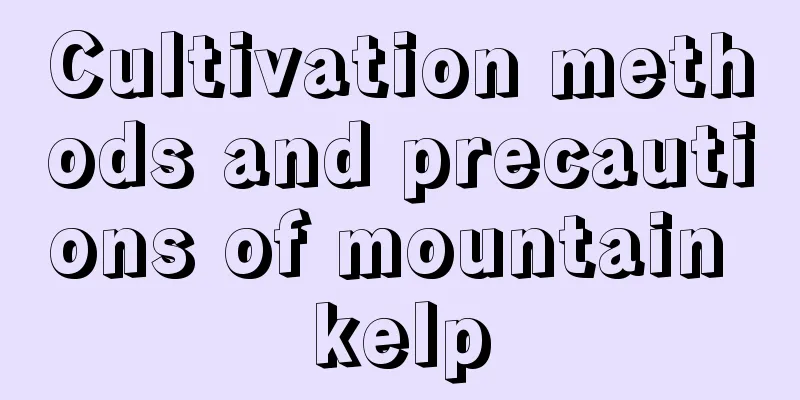Cultivation methods and precautions of mountain kelp

1. Maintenance methods1. Light: Kelp is a light-loving plant and should be given sufficient sunlight. In summer, it is necessary to shield it from strong light to avoid being exposed to the sun. But don't let it get too shaded, otherwise the leaves will become limp. 2. Temperature: It is a plant that likes high temperatures and is suitable for growing in an environment of 20-28℃. It has some cold resistance and can continue to grow above 10℃ and can withstand short-term low temperatures around 0℃. 3. Soil: It has no requirements for the soil. It is best to use loose, acidic soil with good drainage. Also, the soil must be disinfected before use. 4. Water: Water it once or twice a week during the spring and summer, and once every 3-4 days in the autumn. After it enters a dormant period in winter, you can water it once a week. 2. Breeding techniques1. Repotting: Repotting is necessary after two to three years of maintenance, because the air permeability of the soil will deteriorate if the time is too long. When repotting, you need to change the soil, remove the plant from the pot without damaging the roots, and replant it. 2. Reproduction: Kelp can be propagated by sowing. The temperature should be kept at around 20-25℃ during sowing. Buy seeds of good quality, sow them evenly, and they will germinate after 15 days. 3. Problem diagnosis and treatment1. Leaf spot disease: At the beginning, there will be black spots on the leaves, and the spots will continue to expand, causing the leaves to dry up. While pruning the diseased leaves, you should also spray medicine. You can use thiophanate-methyl or carbendazim for prevention and control. 2. Soft leaves: This phenomenon usually occurs because there is not enough light or too little fertilizer. It should be given plenty of sunlight and adequate fertilizer. IV. Other issues1. Can it be raised indoors? It likes sunlight, but it can also be raised indoors, but you must choose a location with good light. 2. Is it edible? Information on kelp shows that it is non-toxic, but it should not be eaten. Just keep it at home and take good care of it. |
<<: Cultivation methods and precautions of Amomum villosum
>>: The cultivation methods and precautions of tamarind
Recommend
How to hydroponically cultivate lotus
1. Prepare the basin Since this plant likes to ca...
Can litchi be grown in Henan?
Can litchi be grown in Henan? It is possible to g...
How many years does it take for loquat seedlings to bear fruit?
In many areas of our country, loquat trees are a ...
Varieties of Plane Flower
A variant of the plane flower, the small plane fl...
How often should you water your poinsettia?
1. Watering principles Before watering it, always...
The correct way to prune grapes
Pruning grapevines is an important step in ensuri...
What plants to put at the door to attract wealth
1. Fortune Tree The money tree is a tree that is ...
Hydroponic method of rubber tree
Hydroponics Method The hydroponic method of rubbe...
What is the tree of Akebia
1. What kind of tree is it? Abelia is a deciduous...
What are the types of peonies?
1. Crown type This species is characterized by th...
How often should I water Clivia?
1. Frequency of watering The frequency of waterin...
How to grow the gorgeous windmill succulent to make it bloom
Growth conditions of gorgeous windmill succulent ...
How to plant bulb seeds
1. Soil requirements for seed planting Bulbs do n...
How to water a Clivia seedling
1. How to water Observe the growth of the one-lea...
How often should I water my ping pong chrysanthemums? How many times a day should I water them?
1. How often to water How often you water the chr...









